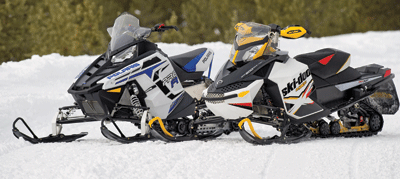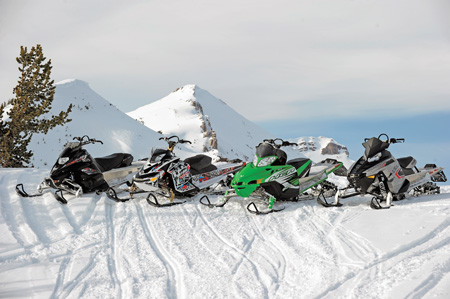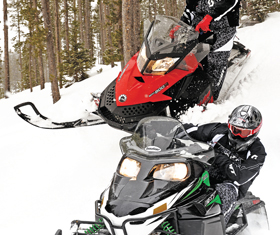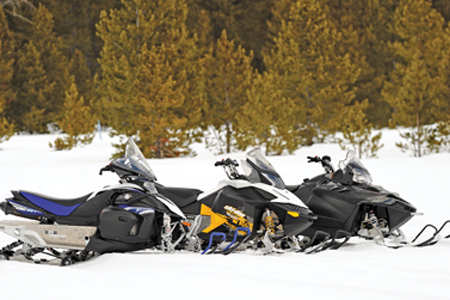 Let’s be honest. These machines aren’t considered sexy by many riders. You won’t find an Arctic Cat F570 featured on the cover of the factory brochure. A Ski-Doo GSX 550 won’t be on center stage in a showroom and the Yamaha Phazer GT isn’t the sled in Yamaha’s lineup with the longest lines for a demo ride.
Let’s be honest. These machines aren’t considered sexy by many riders. You won’t find an Arctic Cat F570 featured on the cover of the factory brochure. A Ski-Doo GSX 550 won’t be on center stage in a showroom and the Yamaha Phazer GT isn’t the sled in Yamaha’s lineup with the longest lines for a demo ride.
But each of these machines is a popular choice for people who prioritize value, comfort and practicality. Considering these features, and in that order, we put these three machines head-to-head-to-head. We’ve also talked to plenty of snowmobilers who have one of these as a second machine in the household for a spouse, kids or friends, which means it also serves as the backup sled if machine No. 1 — often a performance trail machine — is down for repair.
The good news is that despite understated graphics, smaller displacement engines and smaller price tags, these machines are every bit capable. Each has a chassis that evolved from a higher-performance trail version or racing pedigree, but with calibrations pegged on plush.
In addition to the comfortable, groomed trail cruising, with performance lineage, it was fair for us to run each of these like the brochure-cover snowmobiles, measuring performance attributes such as handling, power and overall performance. None of them will win a race on a wide, clear straightaway, and these machines aren’t an obvious (or suitable) choice if you have a performance-first mantra. But put any of them in the woods and they can hold their own against machines with much greater price tags.
Each of these comfortable snowmobiles is a fantastic family machine with wide appeal and capability, but each has its own personality.

A Walk Around
The Twin Spar chassis, the backbone of the Arctic Cat F570, dates to the 2007 model year. While it isn’t a race-proven chassis, this trail performance chassis was engineered to be strong and have premium ride quality for enjoying trails of every condition. It was a no-brainer for Arctic Cat to put the 570 fan-cooled, cylinder-reed engine into the Twin Spar for 2008, and the F570 was born. Each subsequent model year, Arctic Cat has refined the Twin Spar and the company’s value machine has been a happy recipient.
Among the F570’s updates for 2010 are a new ski that promotes improved handling and cornering bite, revised running boards with better grip and seat-to-tunnel fitment changes. The trunk is lost in exchange for eight fewer pounds. Total weight loss on the sled is in the neighborhood of 15 pounds.

The best upgrade to the F570 is the move to a more user-friendly, push-button reverse. Like other systems found on Ski-Doo and Polaris two-strokes, the engine spins backward, eliminating the need for extra gears and linkage. It’s easier to use and accounts for five pounds of the total weight reduction.
The Ski-Doo GSX Sport 550 is in its first season in the lightweight REV-XP, the company’s trail performance chassis. It was assumed the REV-XP would be the common performance platform, and now in its third season, the fan-cooled engines get the ergonomic, handling and performance benefits of the XP backbone.
With the XP chassis, the assumption is true: of the three machines here, the GSX is the lightest. Compared to last season’s version of the GSX Sport Fan in the original REV chassis, the 2010 GSX Sport 550 is 27 pounds lighter. Ski-Doo claims that in addition to its weight reduction, the engine sits 1 inch lower in the new chassis for improved handling and roll characteristics with a lower center of gravity.

Because the GSX is in a new chassis for 2010, it has the across-the-board upgrades, like improved ergonomics, and upgrades new to all XP machines, including revised steering geometry that reduces steering effort by a claimed 20 percent over previous XP models.
Ski-Doo’s race machines are little more than this same XP trail chassis with reinforcements. The GSX has many of its parts evolved from the track. Its SC-5 rear suspension is used across the model portfolio and is the company’s latest ware for tackling the toughest terrain. The economy-focused GSX Sport 550 uses that skid in its most current form, but it has bargain shelf shocks bolted in place to help keeps costs aimed at the value-conscious.
To those in the know, the word “Phazer” has been synonymous with “radical” throughout snowmobile history. When the Yamaha Phazer first appeared in 1984 it was a departure from common snowmobile styling, and the same held true for the new Phazer generation that appeared in 2007. Its minimalist style, chassis innovation and its market impact led Snow Goer to name the Yamaha Phazer as its 2007 Snowmobile of the Year.

The 2010 Phazer GT is built on the same platform as the award-winner and the chassis on the sister Phazer RTX has ample experience in cross-country racing. The FX chassis uses an exclusive die-cast aluminum frame that keeps weight minimized without compromising structural integrity. The rigid, formed structure also integrates subcomponents like a traditional chaincase for fewer parts and greater durability.
In its four model years the Phazer GT has been updated steadily with durability and rider comfort improvements but the soul of the machine has remained unchanged. For 2010, improvements are larger, more effective handwarmers and the only color option is black.
Trying Them On
Arctic Cat’s F570 is comfortable. The machine’s dimensions are large by comparison, which for some riders feels more safe and secure. How well each machine feels is an important purchase decision — especially for a machine designed to attract riders who aren’t performance-first. The large dimensions also create a roomy cockpit to accommodate riders of all sizes and a variety of positions.
The larger chassis and more conventional seating arrangement also benefit the rider with better wind protection than the other two machines on queue. The Cat has a functional windshield that keeps riders warmer but it blocks visibility of the ski tips. Riders sit atop a wide, plush seat and the handlebars are a good height for seated comfort and control. Controls are well appointed with switches easily manipulated without releasing grip from the bar ends, and there is a nice gauge easily read while driving.
In terms of cockpit size, the Ski-Doo GSX Sport 550 is in the middle of this threesome. It has full-size snowmobile dimensions, protection and cockpit room with a compact feel. The seat, a shared component with the performance platforms, could be plusher for greater comfort that touring riders would appreciate. The firm seat is cut as a better match for performance riding. Other machines in the brand catalog share the seat design, but it was noticed as a greater compromise aboard the GSX.
Instead of Ski-Doo’s usual DESS anti-theft tether is a keyed ignition. However, that feel of an obvious cost-cutting measure is excused because this machine has a 12-volt accessory plug and mirrors, the latter being an exclusive feature with this trio.

In the saddle, some riders said they feel too exposed aboard the Yamaha Phazer’s naked styling while others adore it. The riding position, however, had unanimous appeal from our drivers. It features great handlebars, a large, protective windshield and a supportive seat. What the seat lacks in all-day comfort from its narrow dimension it gains in ease of movement. It’s easy to lean into corners to aid front stability. The hooked handlebars add improved control for entry-level riders while accommodating aggressive riders, too.
Yamaha’s Phazer GT is aimed at groomed trail riders, and that is where the machine is most at home. On smooth trails the machine is moderately stable, steers light and has minimal corner push. The Phazer GT comes adorned with premium, GYTR Dual Clicker shocks that adjust for both compression and rebound. We played with the shocks to fine tune the ride and handling. It was the only sled in this test with adjustable shocks.
The Ride
Aboard the Cat, the bars are connected to a front end that steers light. The new skis have a more aggressive keel design yet we noticed no increase in steering effort and push is reduced. The front end pushes ever-so-slightly on uphill turns. It can be tuned out of the ride with some minor skid adjustments to better control weight transfer, but it might come at the expense of ride quality — where the Cat is the clear champion out of this trio. Like other Arctic Cat Twin Spar sleds, the F570 is more isolated from the terrain than a typical snowmobile and many people find preference with the billowy feel.

The engine is likewise smooth. It was upgraded to the 570 II for the 2007 model year with substantial top-end upgrades, but the engine has been on duty and dependable since the 2002 model year. Compared to the Rotax 550 engine in the Ski-Doo GSX, the Cat’s 565cc engine is louder and less responsive, but the Ski-Doo engine doesn’t have to work as hard in its lightweight chassis. But the Yamaha Phazer GT blows both of them away in power, acceleration and speed.
When ridden more aggressively there are some appreciated features that emerge. The hooked bars on the Arctic Cat are a plus, and not just when ridden more quickly. Novice riders like the added leverage and security from slipping off the bar ends, too, which is needed with the long handlebar travel in tight turns.
The front suspension is AWS VII with hydraulic twin tube shocks and the rear is the race-tested Slide Action. The trails were well groomed at the time of our test so we didn’t get a good feel for suspension performance in bumps, but based on previous testing of the suspensions both the front and rear systems offer plush comfort despite the use of economical, hydraulic shocks.
The Ski-Doo GSX Sport 550 is the class lightweight, and it rides like it. Even with a fan-cooled engine, the REV-XP has a lively, responsive feel. The engine is quieter than the Arctic Cat’s fan-cooled engine, but it blows more heat at the rider. It’s a trait welcome on cold days, condemned during milder rides.
We thought unanimously that the GSX handling was predictable. Like other REV-XP sleds, the skis went wherever they were pointed, but compared to the more powerful and heavier liquid-cooled sleds in the same chassis, there was more front-end darting — especially when off the throttle.
The discount shocks help with the price point, but ride quality is hampered. It’s good, but when compared to the more-comfortable Arctic Cat F570, one test driver described it as “wooden.” It’s easier to make heavier vehicles more compliant, and making a lightweight machine plush is a greater struggle when using the Doo’s Motion Control gas bag shocks. It’s a detail that emerges when compared directly to other machines in the same class.
Comfort is still good, and it had better be because it’s where the GSX models are calibrated, but any speed greater than a comfortable cruise will leave heavier riders wanting more compression resistance. We tested the machine with the springs on the stiffest setting and riders between 190 and 200 pounds thought it was still too soft.
Excessive intake noise, poor mileage and the two-stroke smell are strikes against the two fan-cooled sleds that riders don’t have to tolerate aboard the Phazer, but the Phazer has some undesired characteristics of its own. The Genesis 80 FI engine revs quickly and responds to the driver willingly to get to the meat of the powerband, but the throttle effort is greater than the average for an EFI machine and there is a high-rpm buzz in the handlebars and footrests. Add the buzz to the combination of high-rpm noise and exhaust note and it adds up to a less quiet and calm four-stroke than Yamaha’s other Genesis snowmobile engines. An advanced fuel injection system makes the engine run precisely and is a key ingredient to the rider’s overall quality impression, which is positive.
Though the Phazer is best on groomed trails, it will satisfy a more aggressive rider better than the others in the comparison due to its shock calibrations and adjustability and engine power.
In the factory settings during our test, handling on the Yamaha Phazer GT was predictable and adequately stable but it had some darting and corner push. We softened the front springs and removed some compression from the shocks to improve handling. The added sit-in helped make the front bite and reduced the corner push and gave us more positive steering, but it came at the expense of added chassis roll, which made it busier with fidgety, inside ski lift.
The Dual Shock rear suspension features a conventional torsion spring design and it’s one of Yamaha’s best for varied trail conditions. It has class competitive performance and uses KYB gas cell shocks with a nice factory damping calibration for a wide range of riders — a better range than the GSX offers.




